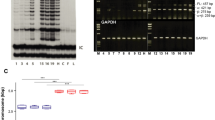Summary
Human foreskin fibroblasts transformed by representative chemicals from five different classes of chemical carcinogens, some requiring enzymatic activation and direct acting carcinogens, produced cell populations that exhibited anchorage-independent growth and expression of neoplastic potential in either nude mice or chick-embryonic skin (CES). There is a high degree of correlation between tumor incidence and invasiveness of CES. The unique feature of CES is the rapidity of expression of cellular neoplasia and interpretation of the simulated tumor in 4 d as a simulated fibrosarcoma. This method represents a system that can be used to evaluate human carcinogens in vitro in 6 to 10 wk.
Similar content being viewed by others
References
Milo, G.; Di Paolo, J. Neoplastic transformation of human diploid cellsin vitro after chemical carcinogen treatment. Nature 275: 130–132; 1978.
Milo, G.; Di Paolo, J. Presensitization of human cells with extrinsic signals to induced chemical carcinogenesis. Int. J. Cancer 26: 805–812; 1980.
Greiner, J. W.; Evans, C. H.; DiPaolo, J. A. Carcinogen-induced anchorage-independent growth andin vivo lethality of human MRC-5 cells. Carcinogenesis 2: 359–362; 1981.
Milo, G.; Ackerman, A.; Noyes, I. Growth and ultrastructural characterization of proliferating human keratinocytes in vitro without added extrinsic factors. In Vitro 16: 20–30; 1980.
Donahoe, J.; Noyes, I.; Weisbrode, S.; Schumm, D.; Milo, G. A suitable rapid in vitro organ culture system to evaluate neoplasia exhibited by carcinogen transformed human fibroblasts. Proc. Am. Assoc. Cancer Res. 22: 117; 1981.
Milo, G.; Oldham, J.; Zimmerman, R.; Hatch, G.; Weisbrode, S. Characterization of human cells transformed by chemical and physical carcinogens, in vitro. In Vitro 17: 719–729; 1981.
Milo, G. E.; Weisbrode, S. A.; Zimmerman, R.; McCloskey, J.A. Ultraviolet radiation-induced neoplastic transformation of normal human cells, in vitro. Chem. Biol. Interact. 36: 45–59; 1981.
Giovanella, B.; Nilsson, K.; Zech, L.; Klein, G.; Stehlin, J. Growth of diploid, Epstein-Barr virus carrying human lymphoblastoid cell lines heterotransplanted into nude mice under immunologically privileged conditions. Int. J. Cancer 24: 103–113; 1979.
Noguechi, P.; Johnson, J.; O’Donnell, R.; Petriciani, J. Chick embryonic skin as a rapid organ culture assay for cellular neoplasia. Science 199: 980–983; 1978.
Milo, G. E.; Noyes, I.; Donahoe, J.; Weisbrode, S. Neoplastic transformation of human epithelial cellsin vitro after exposure to chemical carcinogens. Cancer Res. 41: 5096–5102; 1981.
Milo, G.; Olsen, R.; Weisbrode, S.; McCloskey, J. Feline sarcoma virus induced in vitro progression from premalignant to neoplastic transformation of human diploid cells. In Vitro 16: 813–822; 1980.
Author information
Authors and Affiliations
Additional information
This work was supported in part by AFSOR, F49620-80 and the National Cancer Institute, Bethesda, MD, R01-CA-25907.
Rights and permissions
About this article
Cite this article
Donahoe, J., Noyes, I., Milo, G.E. et al. A comparison of expression of neoplastic potential of carcinogen-transformed human fibroblasts in nude mice and in chick embryonic skin. In Vitro Cell.Dev.Biol.-Plant 18, 429–434 (1982). https://doi.org/10.1007/BF02796469
Received:
Accepted:
Issue Date:
DOI: https://doi.org/10.1007/BF02796469




